Financial Statement Analysis of DAMAC Properties
VerifiedAdded on 2019/10/31
|25
|6449
|186
Case Study
AI Summary
This document presents a comprehensive financial statement analysis of DAMAC Properties, a real estate company. It includes an assessment of the company's profitability, liquidity, and solvency using various financial ratios derived from its 2015 and 2016 annual reports. The analysis covers gross profit margin, operating margin, net profit margin, return on capital employed, current ratio, and acid-test ratio. The document also discusses the company's capital structure and potential sources of funding for expansion, including equity shares, retained earnings, and borrowings. Furthermore, it explores the importance of budgeting for modern organizations, highlighting different types of budgets and their relevance in managing business operations. The analysis concludes that while budgeting is crucial, it must be combined with other factors and effective management to achieve success.
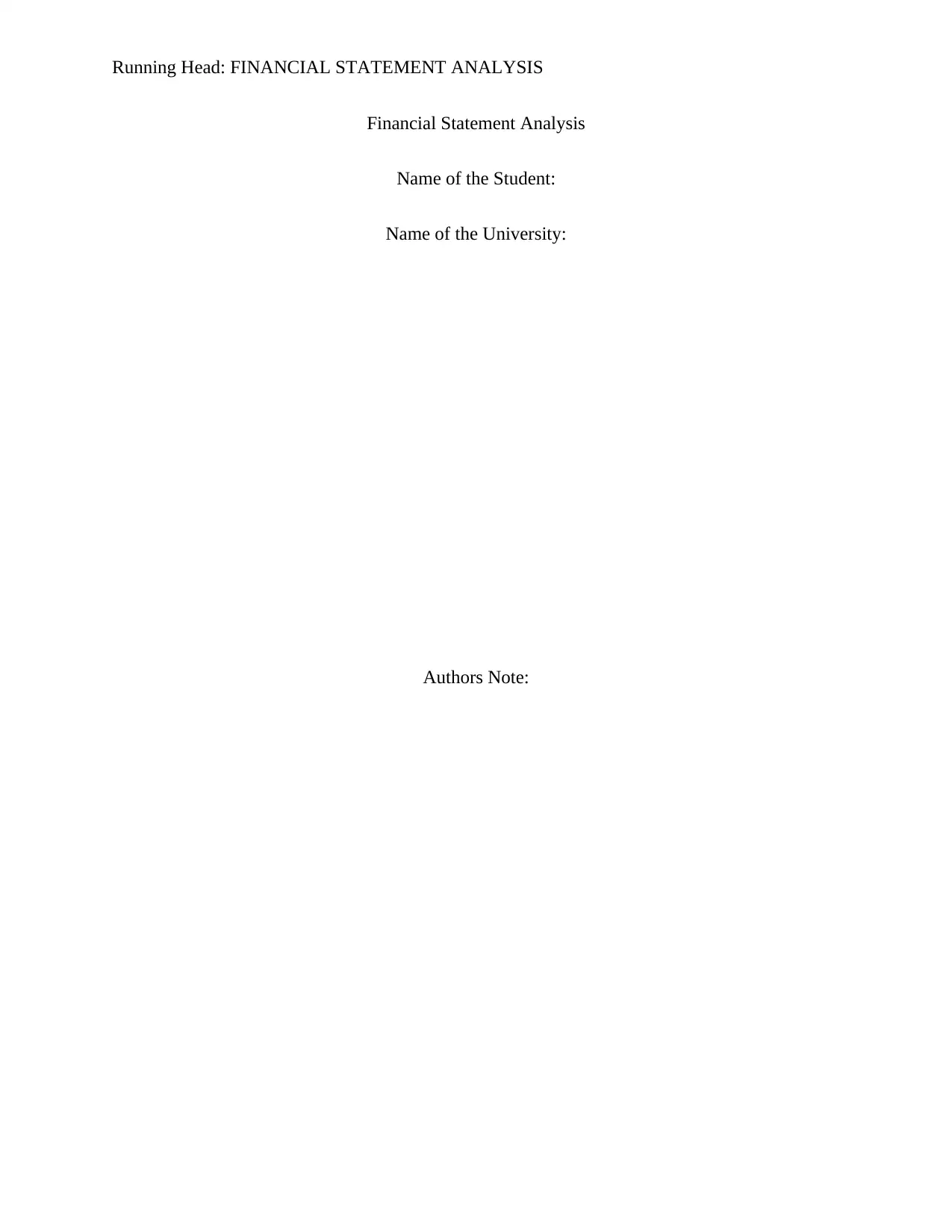
Running Head: FINANCIAL STATEMENT ANALYSIS
Financial Statement Analysis
Name of the Student:
Name of the University:
Authors Note:
Financial Statement Analysis
Name of the Student:
Name of the University:
Authors Note:
Paraphrase This Document
Need a fresh take? Get an instant paraphrase of this document with our AI Paraphraser
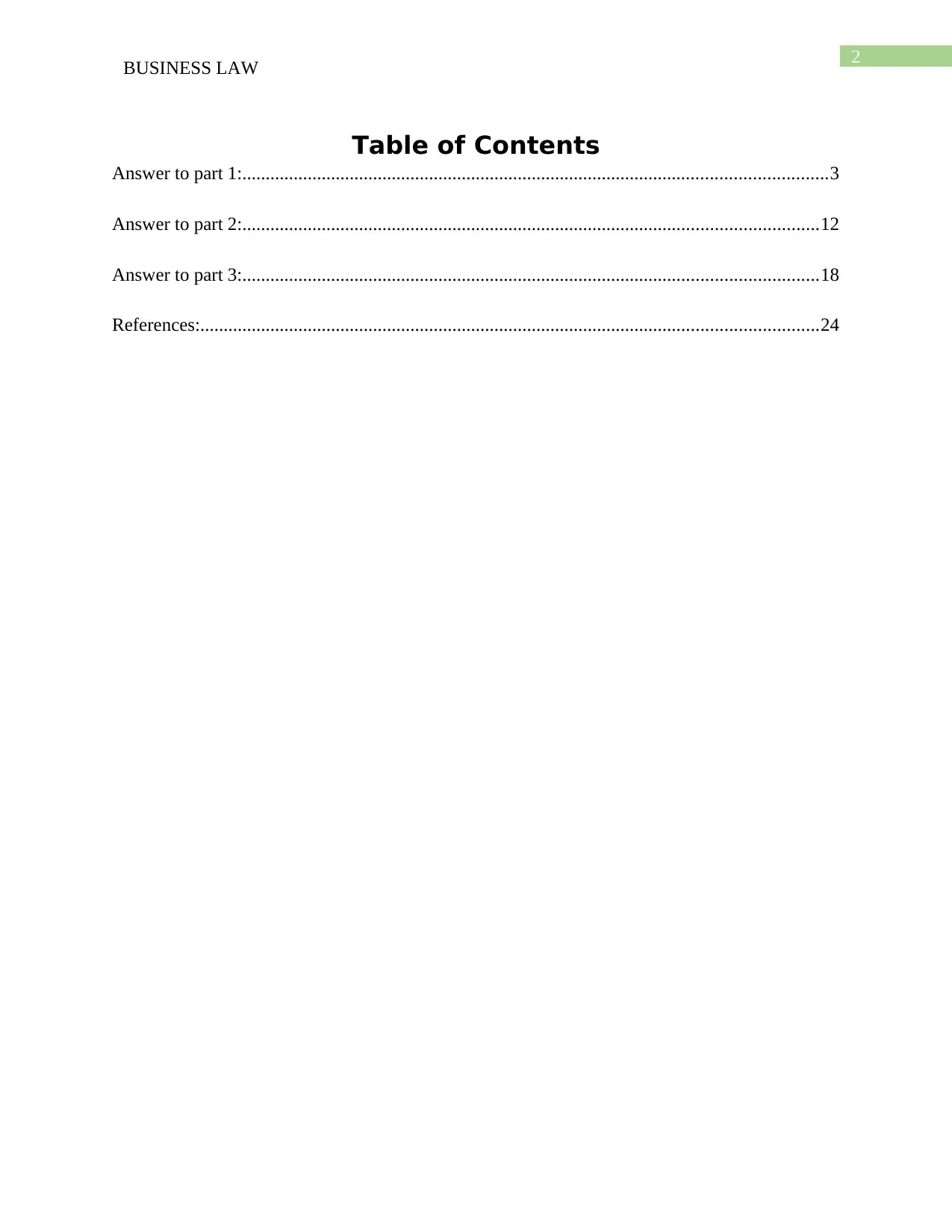
2
BUSINESS LAW
Table of Contents
Answer to part 1:.............................................................................................................................3
Answer to part 2:...........................................................................................................................12
Answer to part 3:...........................................................................................................................18
References:....................................................................................................................................24
BUSINESS LAW
Table of Contents
Answer to part 1:.............................................................................................................................3
Answer to part 2:...........................................................................................................................12
Answer to part 3:...........................................................................................................................18
References:....................................................................................................................................24
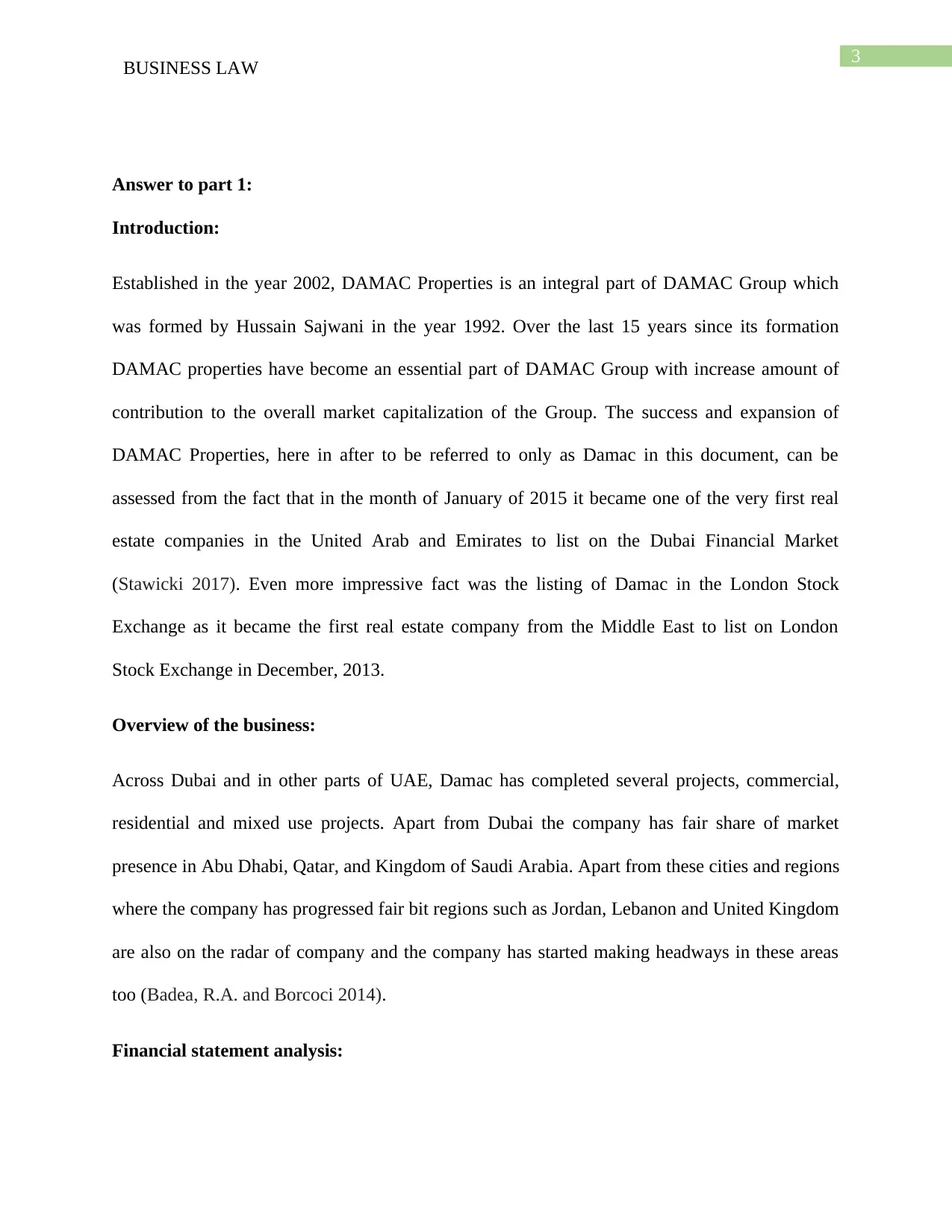
3
BUSINESS LAW
Answer to part 1:
Introduction:
Established in the year 2002, DAMAC Properties is an integral part of DAMAC Group which
was formed by Hussain Sajwani in the year 1992. Over the last 15 years since its formation
DAMAC properties have become an essential part of DAMAC Group with increase amount of
contribution to the overall market capitalization of the Group. The success and expansion of
DAMAC Properties, here in after to be referred to only as Damac in this document, can be
assessed from the fact that in the month of January of 2015 it became one of the very first real
estate companies in the United Arab and Emirates to list on the Dubai Financial Market
(Stawicki 2017). Even more impressive fact was the listing of Damac in the London Stock
Exchange as it became the first real estate company from the Middle East to list on London
Stock Exchange in December, 2013.
Overview of the business:
Across Dubai and in other parts of UAE, Damac has completed several projects, commercial,
residential and mixed use projects. Apart from Dubai the company has fair share of market
presence in Abu Dhabi, Qatar, and Kingdom of Saudi Arabia. Apart from these cities and regions
where the company has progressed fair bit regions such as Jordan, Lebanon and United Kingdom
are also on the radar of company and the company has started making headways in these areas
too (Badea, R.A. and Borcoci 2014).
Financial statement analysis:
BUSINESS LAW
Answer to part 1:
Introduction:
Established in the year 2002, DAMAC Properties is an integral part of DAMAC Group which
was formed by Hussain Sajwani in the year 1992. Over the last 15 years since its formation
DAMAC properties have become an essential part of DAMAC Group with increase amount of
contribution to the overall market capitalization of the Group. The success and expansion of
DAMAC Properties, here in after to be referred to only as Damac in this document, can be
assessed from the fact that in the month of January of 2015 it became one of the very first real
estate companies in the United Arab and Emirates to list on the Dubai Financial Market
(Stawicki 2017). Even more impressive fact was the listing of Damac in the London Stock
Exchange as it became the first real estate company from the Middle East to list on London
Stock Exchange in December, 2013.
Overview of the business:
Across Dubai and in other parts of UAE, Damac has completed several projects, commercial,
residential and mixed use projects. Apart from Dubai the company has fair share of market
presence in Abu Dhabi, Qatar, and Kingdom of Saudi Arabia. Apart from these cities and regions
where the company has progressed fair bit regions such as Jordan, Lebanon and United Kingdom
are also on the radar of company and the company has started making headways in these areas
too (Badea, R.A. and Borcoci 2014).
Financial statement analysis:
⊘ This is a preview!⊘
Do you want full access?
Subscribe today to unlock all pages.

Trusted by 1+ million students worldwide
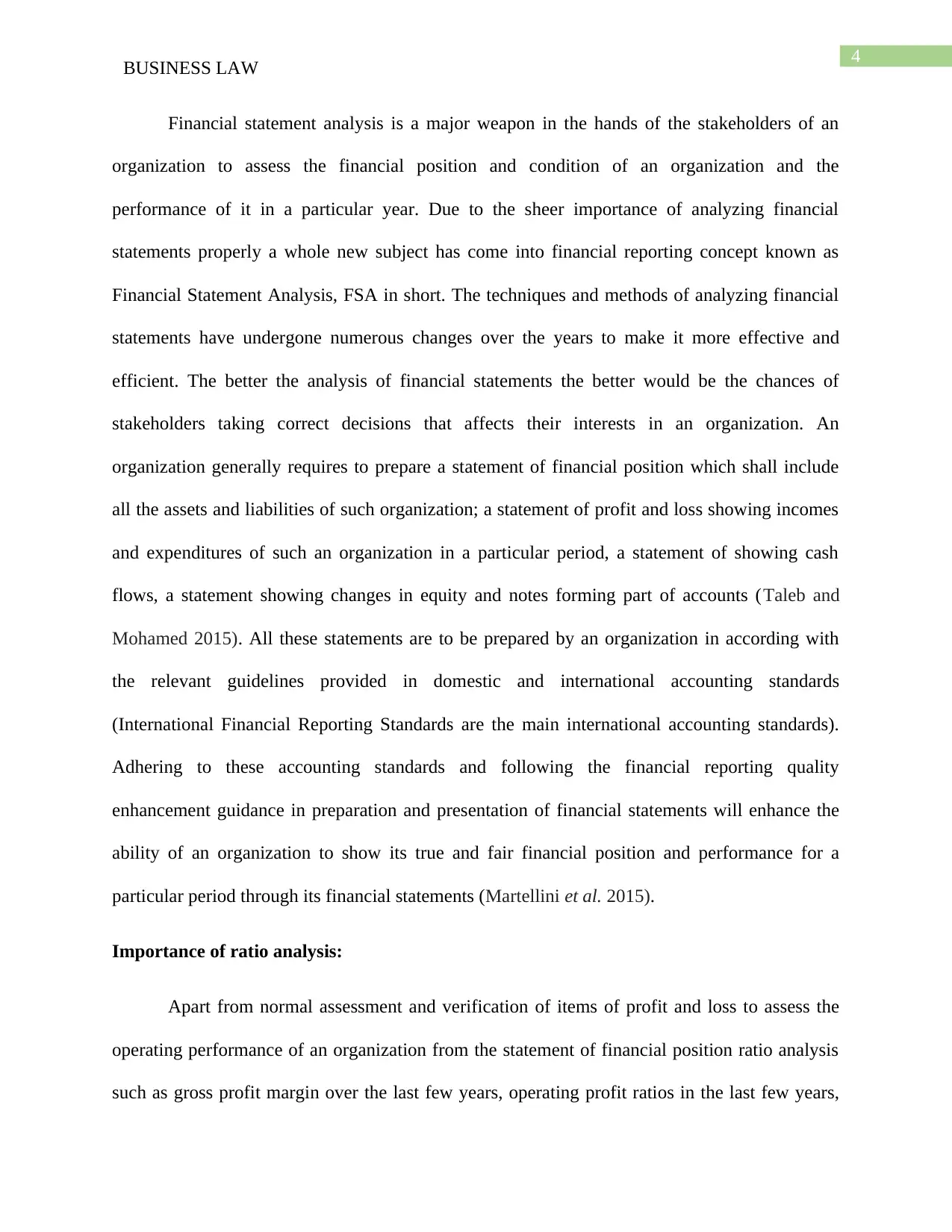
4
BUSINESS LAW
Financial statement analysis is a major weapon in the hands of the stakeholders of an
organization to assess the financial position and condition of an organization and the
performance of it in a particular year. Due to the sheer importance of analyzing financial
statements properly a whole new subject has come into financial reporting concept known as
Financial Statement Analysis, FSA in short. The techniques and methods of analyzing financial
statements have undergone numerous changes over the years to make it more effective and
efficient. The better the analysis of financial statements the better would be the chances of
stakeholders taking correct decisions that affects their interests in an organization. An
organization generally requires to prepare a statement of financial position which shall include
all the assets and liabilities of such organization; a statement of profit and loss showing incomes
and expenditures of such an organization in a particular period, a statement of showing cash
flows, a statement showing changes in equity and notes forming part of accounts (Taleb and
Mohamed 2015). All these statements are to be prepared by an organization in according with
the relevant guidelines provided in domestic and international accounting standards
(International Financial Reporting Standards are the main international accounting standards).
Adhering to these accounting standards and following the financial reporting quality
enhancement guidance in preparation and presentation of financial statements will enhance the
ability of an organization to show its true and fair financial position and performance for a
particular period through its financial statements (Martellini et al. 2015).
Importance of ratio analysis:
Apart from normal assessment and verification of items of profit and loss to assess the
operating performance of an organization from the statement of financial position ratio analysis
such as gross profit margin over the last few years, operating profit ratios in the last few years,
BUSINESS LAW
Financial statement analysis is a major weapon in the hands of the stakeholders of an
organization to assess the financial position and condition of an organization and the
performance of it in a particular year. Due to the sheer importance of analyzing financial
statements properly a whole new subject has come into financial reporting concept known as
Financial Statement Analysis, FSA in short. The techniques and methods of analyzing financial
statements have undergone numerous changes over the years to make it more effective and
efficient. The better the analysis of financial statements the better would be the chances of
stakeholders taking correct decisions that affects their interests in an organization. An
organization generally requires to prepare a statement of financial position which shall include
all the assets and liabilities of such organization; a statement of profit and loss showing incomes
and expenditures of such an organization in a particular period, a statement of showing cash
flows, a statement showing changes in equity and notes forming part of accounts (Taleb and
Mohamed 2015). All these statements are to be prepared by an organization in according with
the relevant guidelines provided in domestic and international accounting standards
(International Financial Reporting Standards are the main international accounting standards).
Adhering to these accounting standards and following the financial reporting quality
enhancement guidance in preparation and presentation of financial statements will enhance the
ability of an organization to show its true and fair financial position and performance for a
particular period through its financial statements (Martellini et al. 2015).
Importance of ratio analysis:
Apart from normal assessment and verification of items of profit and loss to assess the
operating performance of an organization from the statement of financial position ratio analysis
such as gross profit margin over the last few years, operating profit ratios in the last few years,
Paraphrase This Document
Need a fresh take? Get an instant paraphrase of this document with our AI Paraphraser
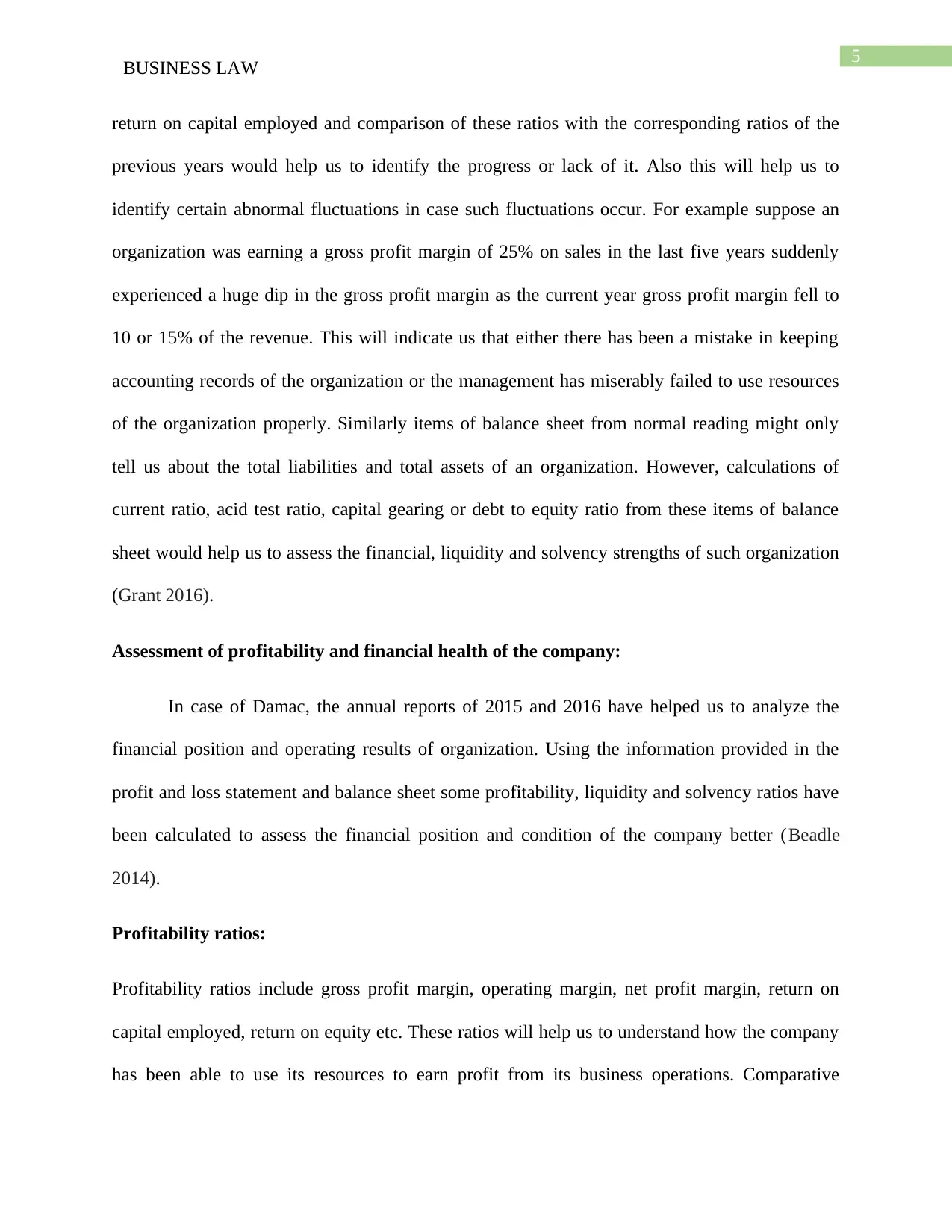
5
BUSINESS LAW
return on capital employed and comparison of these ratios with the corresponding ratios of the
previous years would help us to identify the progress or lack of it. Also this will help us to
identify certain abnormal fluctuations in case such fluctuations occur. For example suppose an
organization was earning a gross profit margin of 25% on sales in the last five years suddenly
experienced a huge dip in the gross profit margin as the current year gross profit margin fell to
10 or 15% of the revenue. This will indicate us that either there has been a mistake in keeping
accounting records of the organization or the management has miserably failed to use resources
of the organization properly. Similarly items of balance sheet from normal reading might only
tell us about the total liabilities and total assets of an organization. However, calculations of
current ratio, acid test ratio, capital gearing or debt to equity ratio from these items of balance
sheet would help us to assess the financial, liquidity and solvency strengths of such organization
(Grant 2016).
Assessment of profitability and financial health of the company:
In case of Damac, the annual reports of 2015 and 2016 have helped us to analyze the
financial position and operating results of organization. Using the information provided in the
profit and loss statement and balance sheet some profitability, liquidity and solvency ratios have
been calculated to assess the financial position and condition of the company better (Beadle
2014).
Profitability ratios:
Profitability ratios include gross profit margin, operating margin, net profit margin, return on
capital employed, return on equity etc. These ratios will help us to understand how the company
has been able to use its resources to earn profit from its business operations. Comparative
BUSINESS LAW
return on capital employed and comparison of these ratios with the corresponding ratios of the
previous years would help us to identify the progress or lack of it. Also this will help us to
identify certain abnormal fluctuations in case such fluctuations occur. For example suppose an
organization was earning a gross profit margin of 25% on sales in the last five years suddenly
experienced a huge dip in the gross profit margin as the current year gross profit margin fell to
10 or 15% of the revenue. This will indicate us that either there has been a mistake in keeping
accounting records of the organization or the management has miserably failed to use resources
of the organization properly. Similarly items of balance sheet from normal reading might only
tell us about the total liabilities and total assets of an organization. However, calculations of
current ratio, acid test ratio, capital gearing or debt to equity ratio from these items of balance
sheet would help us to assess the financial, liquidity and solvency strengths of such organization
(Grant 2016).
Assessment of profitability and financial health of the company:
In case of Damac, the annual reports of 2015 and 2016 have helped us to analyze the
financial position and operating results of organization. Using the information provided in the
profit and loss statement and balance sheet some profitability, liquidity and solvency ratios have
been calculated to assess the financial position and condition of the company better (Beadle
2014).
Profitability ratios:
Profitability ratios include gross profit margin, operating margin, net profit margin, return on
capital employed, return on equity etc. These ratios will help us to understand how the company
has been able to use its resources to earn profit from its business operations. Comparative
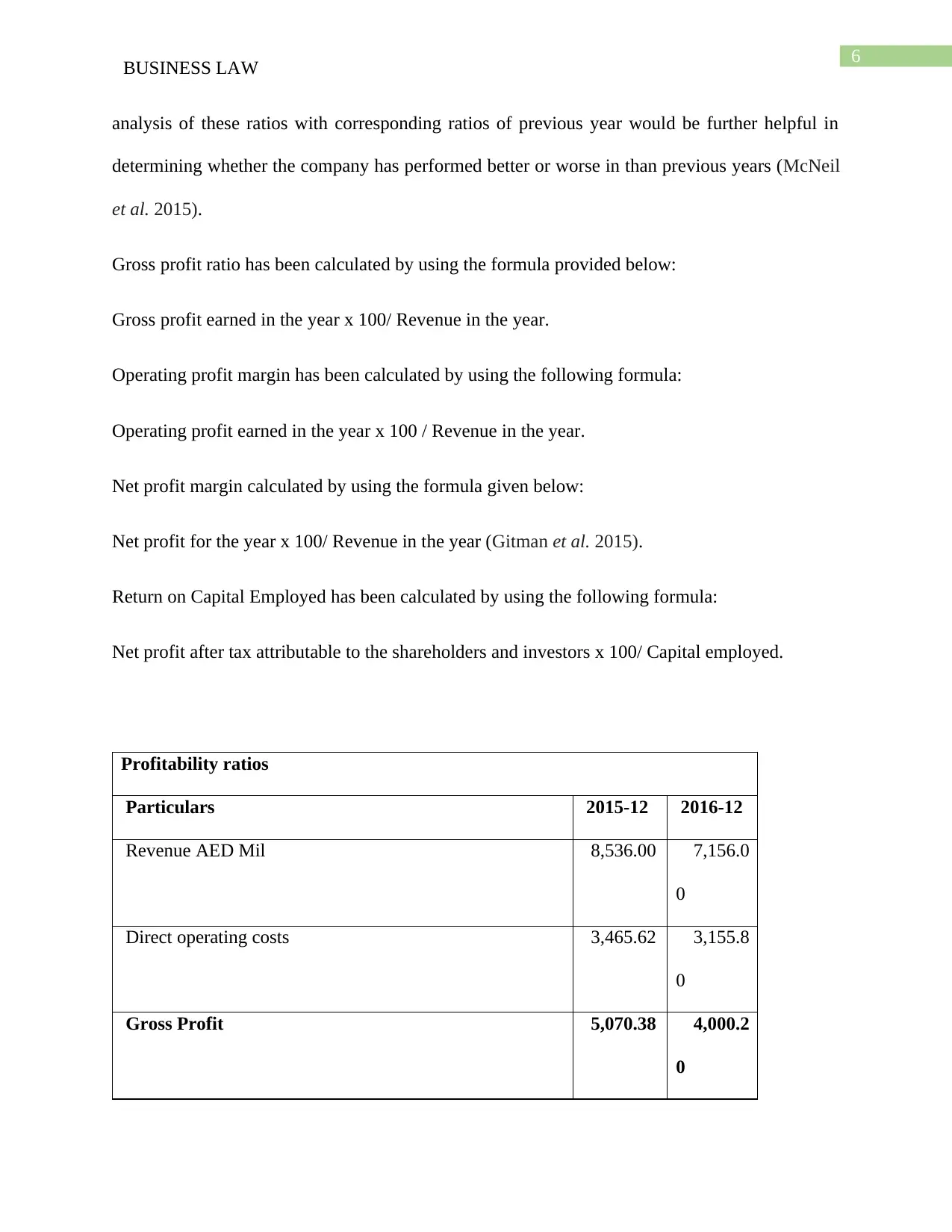
6
BUSINESS LAW
analysis of these ratios with corresponding ratios of previous year would be further helpful in
determining whether the company has performed better or worse in than previous years (McNeil
et al. 2015).
Gross profit ratio has been calculated by using the formula provided below:
Gross profit earned in the year x 100/ Revenue in the year.
Operating profit margin has been calculated by using the following formula:
Operating profit earned in the year x 100 / Revenue in the year.
Net profit margin calculated by using the formula given below:
Net profit for the year x 100/ Revenue in the year (Gitman et al. 2015).
Return on Capital Employed has been calculated by using the following formula:
Net profit after tax attributable to the shareholders and investors x 100/ Capital employed.
Profitability ratios
Particulars 2015-12 2016-12
Revenue AED Mil 8,536.00 7,156.0
0
Direct operating costs 3,465.62 3,155.8
0
Gross Profit 5,070.38 4,000.2
0
BUSINESS LAW
analysis of these ratios with corresponding ratios of previous year would be further helpful in
determining whether the company has performed better or worse in than previous years (McNeil
et al. 2015).
Gross profit ratio has been calculated by using the formula provided below:
Gross profit earned in the year x 100/ Revenue in the year.
Operating profit margin has been calculated by using the following formula:
Operating profit earned in the year x 100 / Revenue in the year.
Net profit margin calculated by using the formula given below:
Net profit for the year x 100/ Revenue in the year (Gitman et al. 2015).
Return on Capital Employed has been calculated by using the following formula:
Net profit after tax attributable to the shareholders and investors x 100/ Capital employed.
Profitability ratios
Particulars 2015-12 2016-12
Revenue AED Mil 8,536.00 7,156.0
0
Direct operating costs 3,465.62 3,155.8
0
Gross Profit 5,070.38 4,000.2
0
⊘ This is a preview!⊘
Do you want full access?
Subscribe today to unlock all pages.

Trusted by 1+ million students worldwide
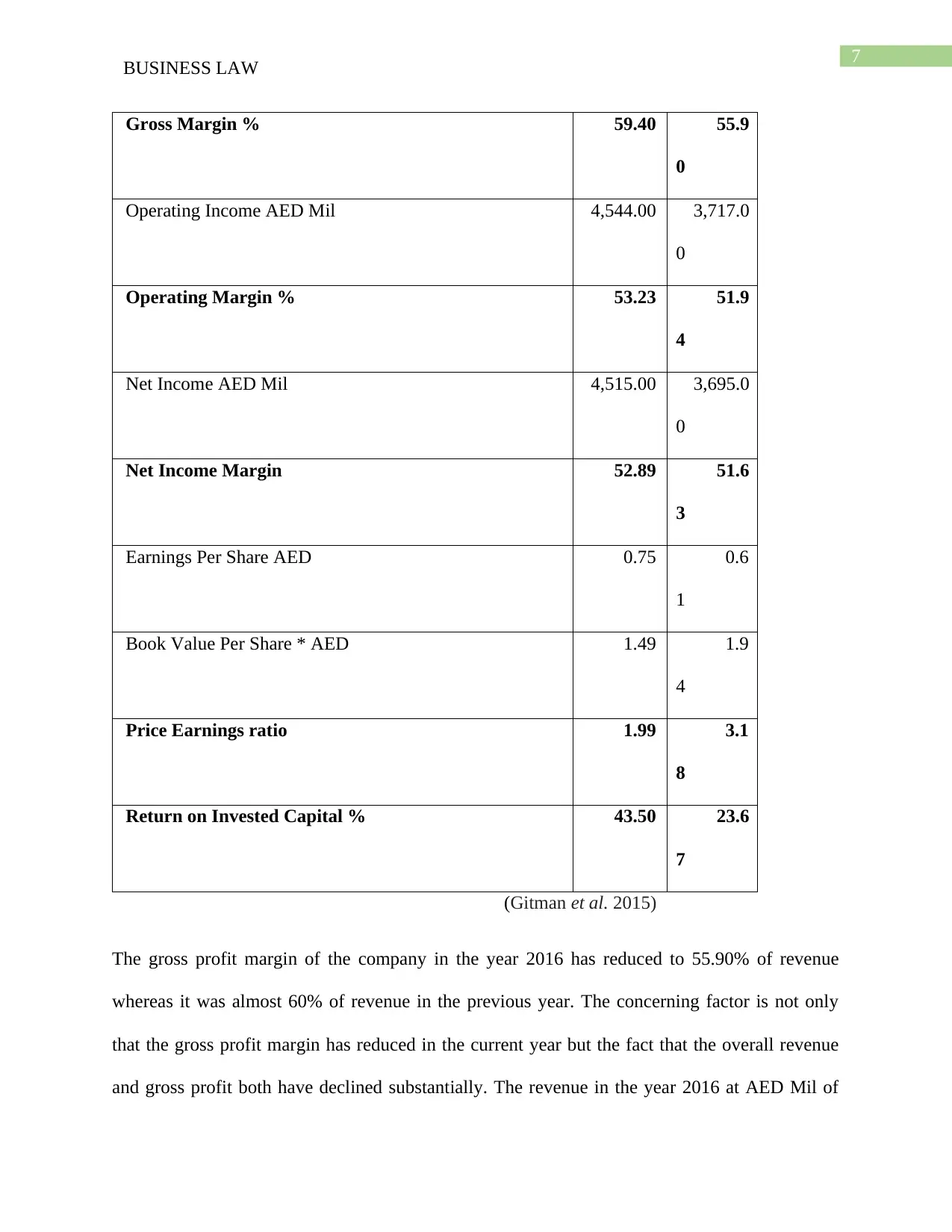
7
BUSINESS LAW
Gross Margin % 59.40 55.9
0
Operating Income AED Mil 4,544.00 3,717.0
0
Operating Margin % 53.23 51.9
4
Net Income AED Mil 4,515.00 3,695.0
0
Net Income Margin 52.89 51.6
3
Earnings Per Share AED 0.75 0.6
1
Book Value Per Share * AED 1.49 1.9
4
Price Earnings ratio 1.99 3.1
8
Return on Invested Capital % 43.50 23.6
7
(Gitman et al. 2015)
The gross profit margin of the company in the year 2016 has reduced to 55.90% of revenue
whereas it was almost 60% of revenue in the previous year. The concerning factor is not only
that the gross profit margin has reduced in the current year but the fact that the overall revenue
and gross profit both have declined substantially. The revenue in the year 2016 at AED Mil of
BUSINESS LAW
Gross Margin % 59.40 55.9
0
Operating Income AED Mil 4,544.00 3,717.0
0
Operating Margin % 53.23 51.9
4
Net Income AED Mil 4,515.00 3,695.0
0
Net Income Margin 52.89 51.6
3
Earnings Per Share AED 0.75 0.6
1
Book Value Per Share * AED 1.49 1.9
4
Price Earnings ratio 1.99 3.1
8
Return on Invested Capital % 43.50 23.6
7
(Gitman et al. 2015)
The gross profit margin of the company in the year 2016 has reduced to 55.90% of revenue
whereas it was almost 60% of revenue in the previous year. The concerning factor is not only
that the gross profit margin has reduced in the current year but the fact that the overall revenue
and gross profit both have declined substantially. The revenue in the year 2016 at AED Mil of
Paraphrase This Document
Need a fresh take? Get an instant paraphrase of this document with our AI Paraphraser
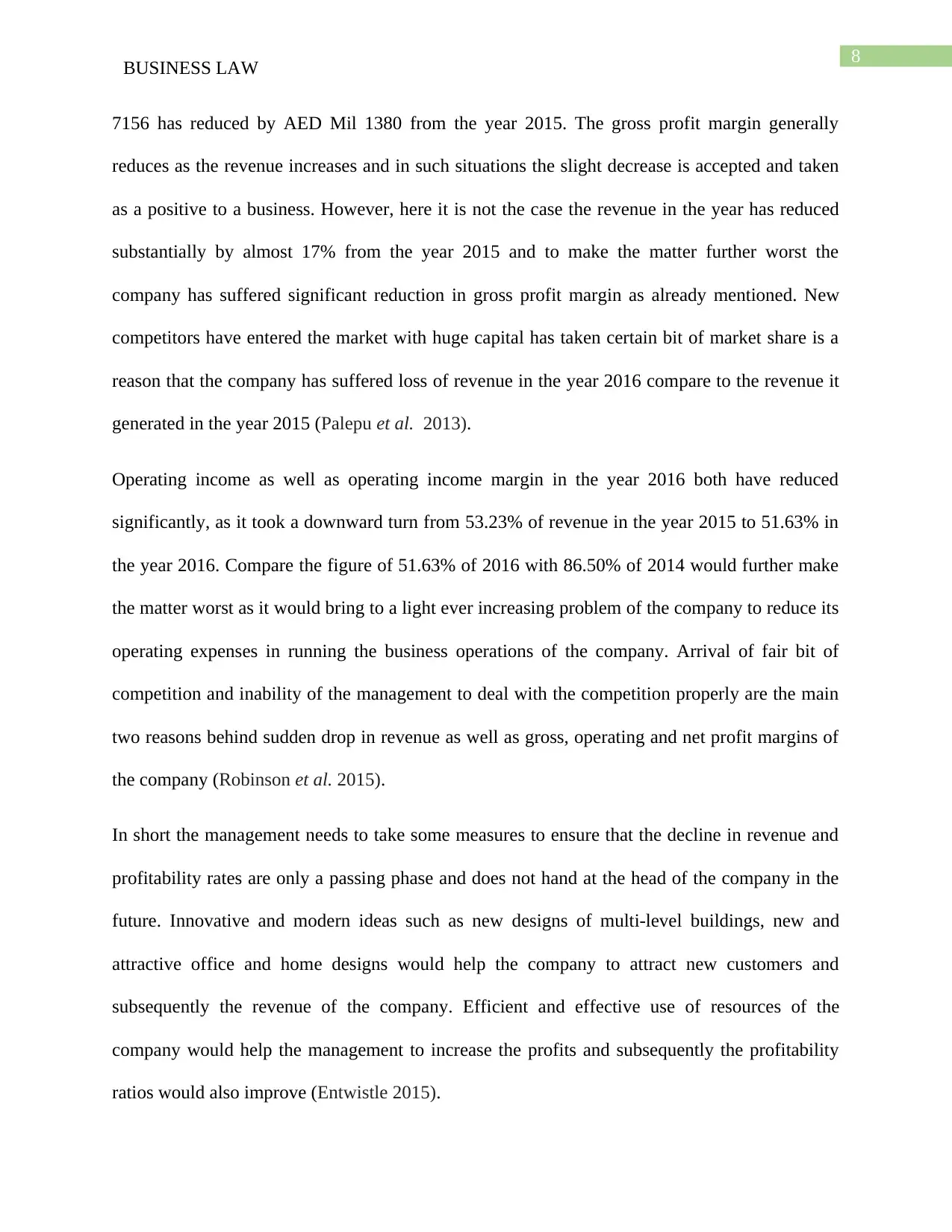
8
BUSINESS LAW
7156 has reduced by AED Mil 1380 from the year 2015. The gross profit margin generally
reduces as the revenue increases and in such situations the slight decrease is accepted and taken
as a positive to a business. However, here it is not the case the revenue in the year has reduced
substantially by almost 17% from the year 2015 and to make the matter further worst the
company has suffered significant reduction in gross profit margin as already mentioned. New
competitors have entered the market with huge capital has taken certain bit of market share is a
reason that the company has suffered loss of revenue in the year 2016 compare to the revenue it
generated in the year 2015 (Palepu et al. 2013).
Operating income as well as operating income margin in the year 2016 both have reduced
significantly, as it took a downward turn from 53.23% of revenue in the year 2015 to 51.63% in
the year 2016. Compare the figure of 51.63% of 2016 with 86.50% of 2014 would further make
the matter worst as it would bring to a light ever increasing problem of the company to reduce its
operating expenses in running the business operations of the company. Arrival of fair bit of
competition and inability of the management to deal with the competition properly are the main
two reasons behind sudden drop in revenue as well as gross, operating and net profit margins of
the company (Robinson et al. 2015).
In short the management needs to take some measures to ensure that the decline in revenue and
profitability rates are only a passing phase and does not hand at the head of the company in the
future. Innovative and modern ideas such as new designs of multi-level buildings, new and
attractive office and home designs would help the company to attract new customers and
subsequently the revenue of the company. Efficient and effective use of resources of the
company would help the management to increase the profits and subsequently the profitability
ratios would also improve (Entwistle 2015).
BUSINESS LAW
7156 has reduced by AED Mil 1380 from the year 2015. The gross profit margin generally
reduces as the revenue increases and in such situations the slight decrease is accepted and taken
as a positive to a business. However, here it is not the case the revenue in the year has reduced
substantially by almost 17% from the year 2015 and to make the matter further worst the
company has suffered significant reduction in gross profit margin as already mentioned. New
competitors have entered the market with huge capital has taken certain bit of market share is a
reason that the company has suffered loss of revenue in the year 2016 compare to the revenue it
generated in the year 2015 (Palepu et al. 2013).
Operating income as well as operating income margin in the year 2016 both have reduced
significantly, as it took a downward turn from 53.23% of revenue in the year 2015 to 51.63% in
the year 2016. Compare the figure of 51.63% of 2016 with 86.50% of 2014 would further make
the matter worst as it would bring to a light ever increasing problem of the company to reduce its
operating expenses in running the business operations of the company. Arrival of fair bit of
competition and inability of the management to deal with the competition properly are the main
two reasons behind sudden drop in revenue as well as gross, operating and net profit margins of
the company (Robinson et al. 2015).
In short the management needs to take some measures to ensure that the decline in revenue and
profitability rates are only a passing phase and does not hand at the head of the company in the
future. Innovative and modern ideas such as new designs of multi-level buildings, new and
attractive office and home designs would help the company to attract new customers and
subsequently the revenue of the company. Efficient and effective use of resources of the
company would help the management to increase the profits and subsequently the profitability
ratios would also improve (Entwistle 2015).
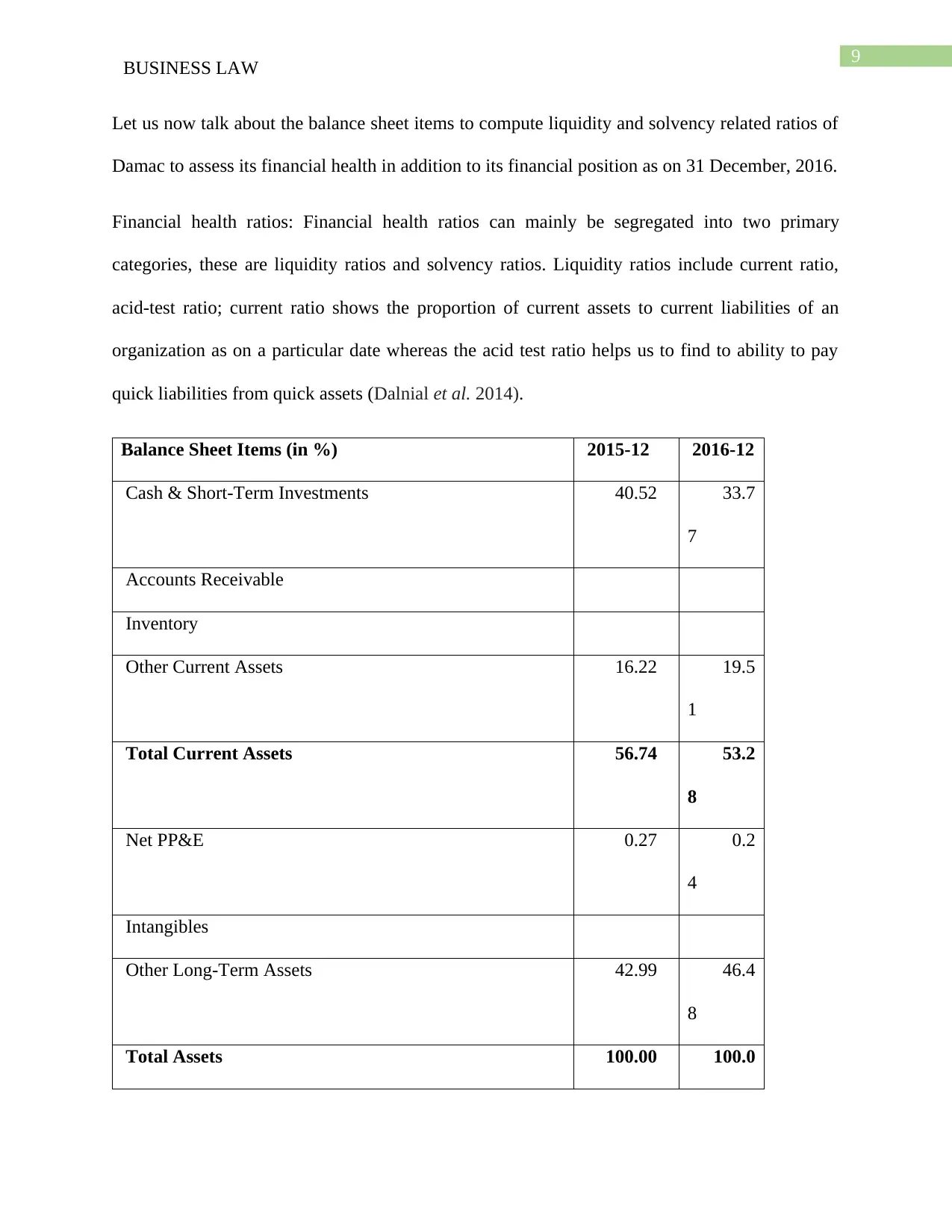
9
BUSINESS LAW
Let us now talk about the balance sheet items to compute liquidity and solvency related ratios of
Damac to assess its financial health in addition to its financial position as on 31 December, 2016.
Financial health ratios: Financial health ratios can mainly be segregated into two primary
categories, these are liquidity ratios and solvency ratios. Liquidity ratios include current ratio,
acid-test ratio; current ratio shows the proportion of current assets to current liabilities of an
organization as on a particular date whereas the acid test ratio helps us to find to ability to pay
quick liabilities from quick assets (Dalnial et al. 2014).
Balance Sheet Items (in %) 2015-12 2016-12
Cash & Short-Term Investments 40.52 33.7
7
Accounts Receivable
Inventory
Other Current Assets 16.22 19.5
1
Total Current Assets 56.74 53.2
8
Net PP&E 0.27 0.2
4
Intangibles
Other Long-Term Assets 42.99 46.4
8
Total Assets 100.00 100.0
BUSINESS LAW
Let us now talk about the balance sheet items to compute liquidity and solvency related ratios of
Damac to assess its financial health in addition to its financial position as on 31 December, 2016.
Financial health ratios: Financial health ratios can mainly be segregated into two primary
categories, these are liquidity ratios and solvency ratios. Liquidity ratios include current ratio,
acid-test ratio; current ratio shows the proportion of current assets to current liabilities of an
organization as on a particular date whereas the acid test ratio helps us to find to ability to pay
quick liabilities from quick assets (Dalnial et al. 2014).
Balance Sheet Items (in %) 2015-12 2016-12
Cash & Short-Term Investments 40.52 33.7
7
Accounts Receivable
Inventory
Other Current Assets 16.22 19.5
1
Total Current Assets 56.74 53.2
8
Net PP&E 0.27 0.2
4
Intangibles
Other Long-Term Assets 42.99 46.4
8
Total Assets 100.00 100.0
⊘ This is a preview!⊘
Do you want full access?
Subscribe today to unlock all pages.

Trusted by 1+ million students worldwide
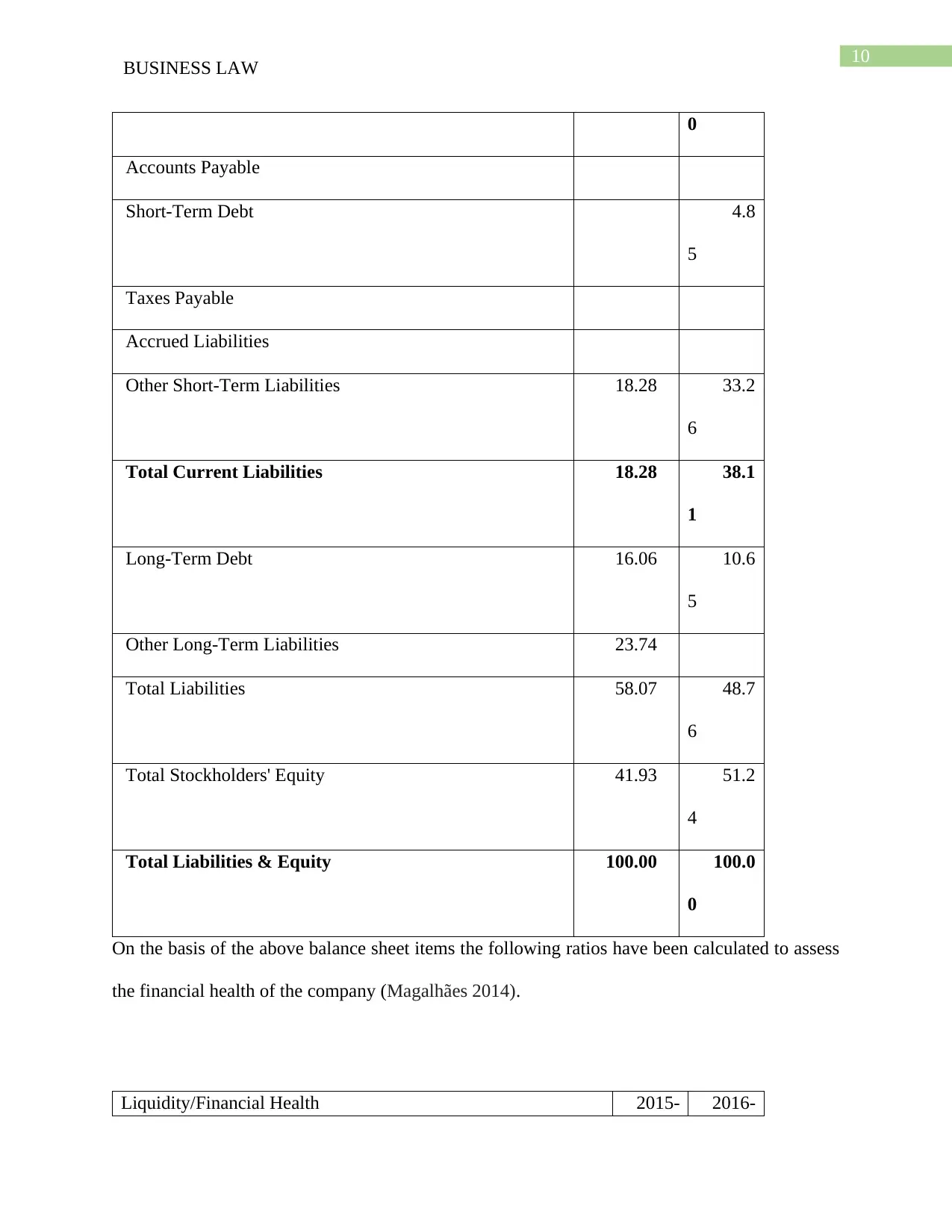
10
BUSINESS LAW
0
Accounts Payable
Short-Term Debt 4.8
5
Taxes Payable
Accrued Liabilities
Other Short-Term Liabilities 18.28 33.2
6
Total Current Liabilities 18.28 38.1
1
Long-Term Debt 16.06 10.6
5
Other Long-Term Liabilities 23.74
Total Liabilities 58.07 48.7
6
Total Stockholders' Equity 41.93 51.2
4
Total Liabilities & Equity 100.00 100.0
0
On the basis of the above balance sheet items the following ratios have been calculated to assess
the financial health of the company (Magalhães 2014).
Liquidity/Financial Health 2015- 2016-
BUSINESS LAW
0
Accounts Payable
Short-Term Debt 4.8
5
Taxes Payable
Accrued Liabilities
Other Short-Term Liabilities 18.28 33.2
6
Total Current Liabilities 18.28 38.1
1
Long-Term Debt 16.06 10.6
5
Other Long-Term Liabilities 23.74
Total Liabilities 58.07 48.7
6
Total Stockholders' Equity 41.93 51.2
4
Total Liabilities & Equity 100.00 100.0
0
On the basis of the above balance sheet items the following ratios have been calculated to assess
the financial health of the company (Magalhães 2014).
Liquidity/Financial Health 2015- 2016-
Paraphrase This Document
Need a fresh take? Get an instant paraphrase of this document with our AI Paraphraser
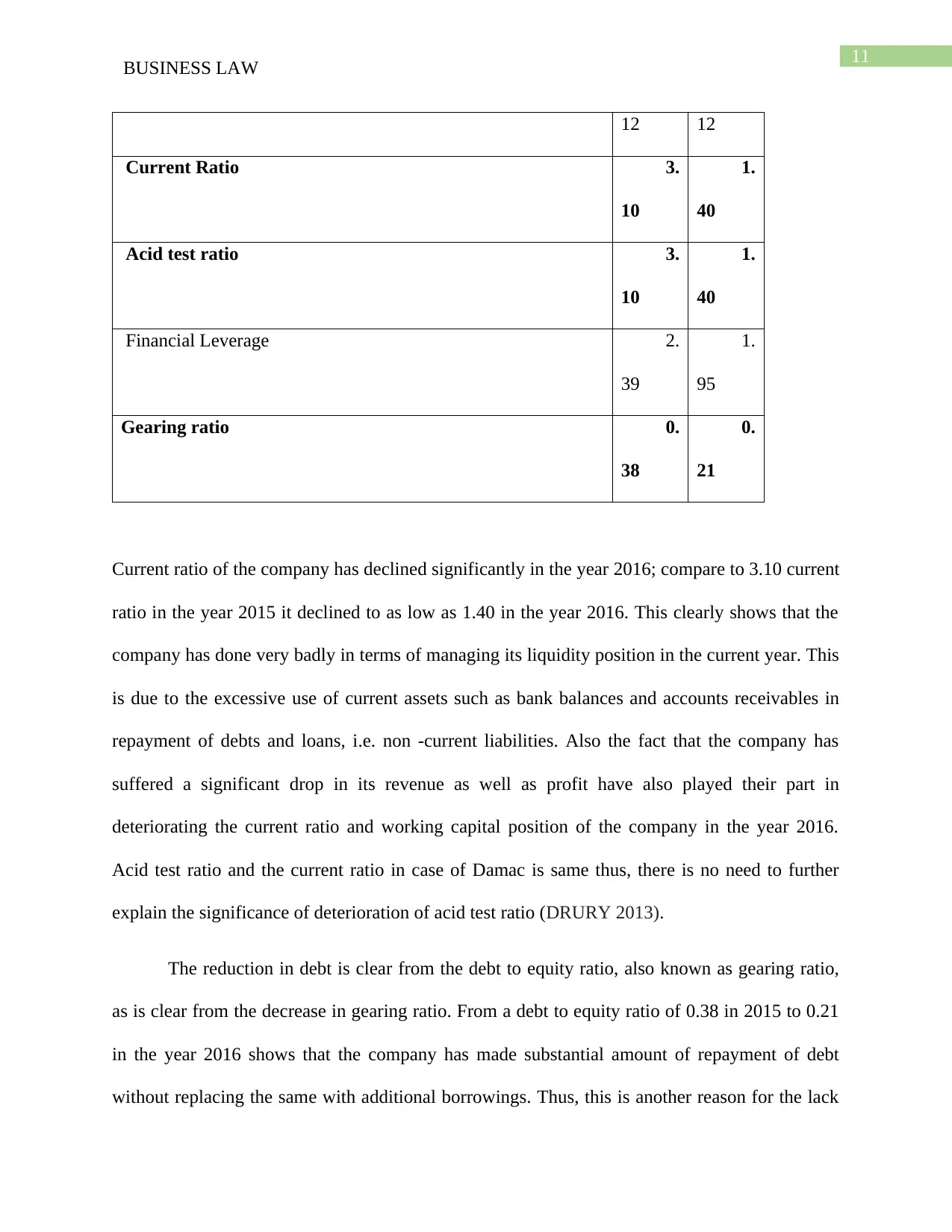
11
BUSINESS LAW
12 12
Current Ratio 3.
10
1.
40
Acid test ratio 3.
10
1.
40
Financial Leverage 2.
39
1.
95
Gearing ratio 0.
38
0.
21
Current ratio of the company has declined significantly in the year 2016; compare to 3.10 current
ratio in the year 2015 it declined to as low as 1.40 in the year 2016. This clearly shows that the
company has done very badly in terms of managing its liquidity position in the current year. This
is due to the excessive use of current assets such as bank balances and accounts receivables in
repayment of debts and loans, i.e. non -current liabilities. Also the fact that the company has
suffered a significant drop in its revenue as well as profit have also played their part in
deteriorating the current ratio and working capital position of the company in the year 2016.
Acid test ratio and the current ratio in case of Damac is same thus, there is no need to further
explain the significance of deterioration of acid test ratio (DRURY 2013).
The reduction in debt is clear from the debt to equity ratio, also known as gearing ratio,
as is clear from the decrease in gearing ratio. From a debt to equity ratio of 0.38 in 2015 to 0.21
in the year 2016 shows that the company has made substantial amount of repayment of debt
without replacing the same with additional borrowings. Thus, this is another reason for the lack
BUSINESS LAW
12 12
Current Ratio 3.
10
1.
40
Acid test ratio 3.
10
1.
40
Financial Leverage 2.
39
1.
95
Gearing ratio 0.
38
0.
21
Current ratio of the company has declined significantly in the year 2016; compare to 3.10 current
ratio in the year 2015 it declined to as low as 1.40 in the year 2016. This clearly shows that the
company has done very badly in terms of managing its liquidity position in the current year. This
is due to the excessive use of current assets such as bank balances and accounts receivables in
repayment of debts and loans, i.e. non -current liabilities. Also the fact that the company has
suffered a significant drop in its revenue as well as profit have also played their part in
deteriorating the current ratio and working capital position of the company in the year 2016.
Acid test ratio and the current ratio in case of Damac is same thus, there is no need to further
explain the significance of deterioration of acid test ratio (DRURY 2013).
The reduction in debt is clear from the debt to equity ratio, also known as gearing ratio,
as is clear from the decrease in gearing ratio. From a debt to equity ratio of 0.38 in 2015 to 0.21
in the year 2016 shows that the company has made substantial amount of repayment of debt
without replacing the same with additional borrowings. Thus, this is another reason for the lack
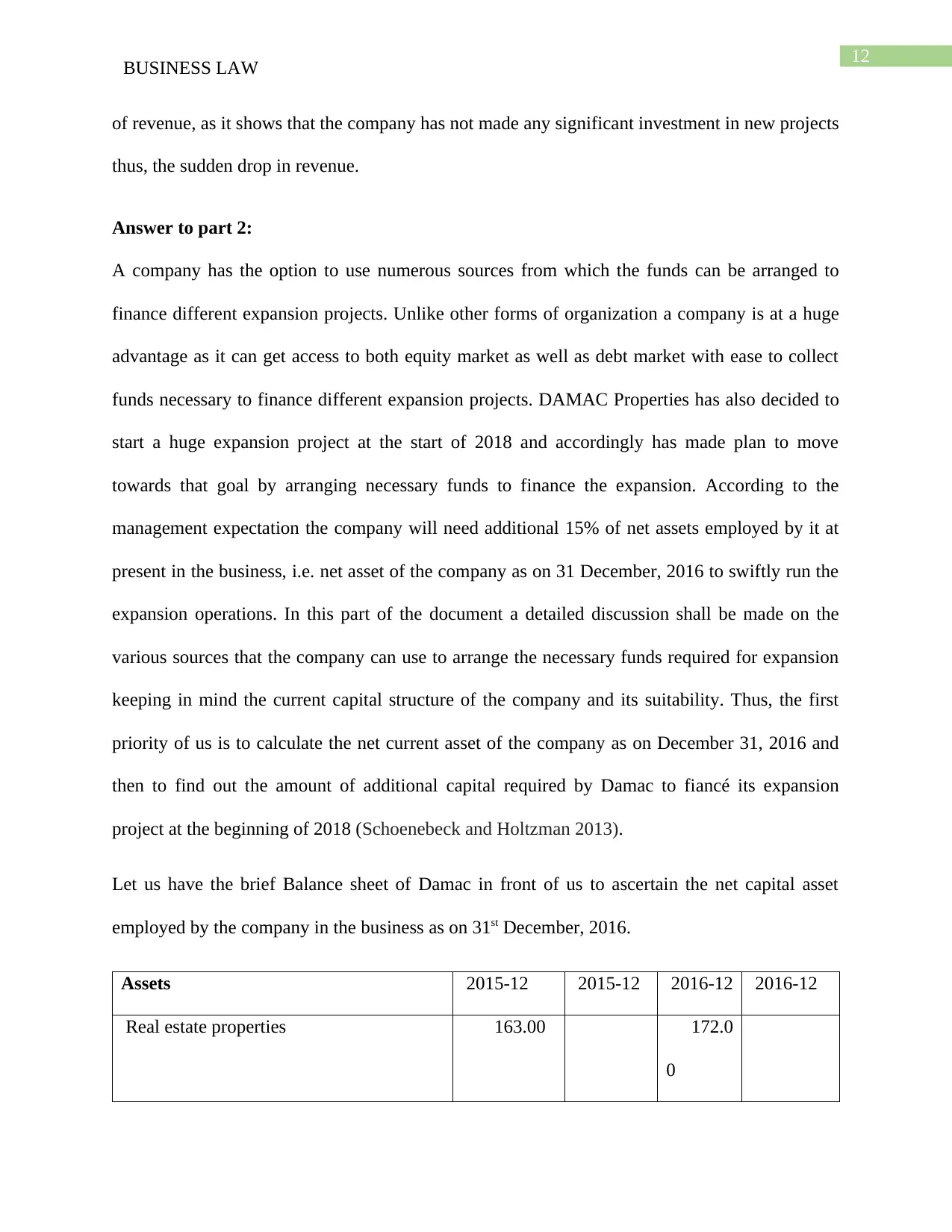
12
BUSINESS LAW
of revenue, as it shows that the company has not made any significant investment in new projects
thus, the sudden drop in revenue.
Answer to part 2:
A company has the option to use numerous sources from which the funds can be arranged to
finance different expansion projects. Unlike other forms of organization a company is at a huge
advantage as it can get access to both equity market as well as debt market with ease to collect
funds necessary to finance different expansion projects. DAMAC Properties has also decided to
start a huge expansion project at the start of 2018 and accordingly has made plan to move
towards that goal by arranging necessary funds to finance the expansion. According to the
management expectation the company will need additional 15% of net assets employed by it at
present in the business, i.e. net asset of the company as on 31 December, 2016 to swiftly run the
expansion operations. In this part of the document a detailed discussion shall be made on the
various sources that the company can use to arrange the necessary funds required for expansion
keeping in mind the current capital structure of the company and its suitability. Thus, the first
priority of us is to calculate the net current asset of the company as on December 31, 2016 and
then to find out the amount of additional capital required by Damac to fiancé its expansion
project at the beginning of 2018 (Schoenebeck and Holtzman 2013).
Let us have the brief Balance sheet of Damac in front of us to ascertain the net capital asset
employed by the company in the business as on 31st December, 2016.
Assets 2015-12 2015-12 2016-12 2016-12
Real estate properties 163.00 172.0
0
BUSINESS LAW
of revenue, as it shows that the company has not made any significant investment in new projects
thus, the sudden drop in revenue.
Answer to part 2:
A company has the option to use numerous sources from which the funds can be arranged to
finance different expansion projects. Unlike other forms of organization a company is at a huge
advantage as it can get access to both equity market as well as debt market with ease to collect
funds necessary to finance different expansion projects. DAMAC Properties has also decided to
start a huge expansion project at the start of 2018 and accordingly has made plan to move
towards that goal by arranging necessary funds to finance the expansion. According to the
management expectation the company will need additional 15% of net assets employed by it at
present in the business, i.e. net asset of the company as on 31 December, 2016 to swiftly run the
expansion operations. In this part of the document a detailed discussion shall be made on the
various sources that the company can use to arrange the necessary funds required for expansion
keeping in mind the current capital structure of the company and its suitability. Thus, the first
priority of us is to calculate the net current asset of the company as on December 31, 2016 and
then to find out the amount of additional capital required by Damac to fiancé its expansion
project at the beginning of 2018 (Schoenebeck and Holtzman 2013).
Let us have the brief Balance sheet of Damac in front of us to ascertain the net capital asset
employed by the company in the business as on 31st December, 2016.
Assets 2015-12 2015-12 2016-12 2016-12
Real estate properties 163.00 172.0
0
⊘ This is a preview!⊘
Do you want full access?
Subscribe today to unlock all pages.

Trusted by 1+ million students worldwide
1 out of 25
Related Documents
Your All-in-One AI-Powered Toolkit for Academic Success.
+13062052269
info@desklib.com
Available 24*7 on WhatsApp / Email
![[object Object]](/_next/static/media/star-bottom.7253800d.svg)
Unlock your academic potential
Copyright © 2020–2025 A2Z Services. All Rights Reserved. Developed and managed by ZUCOL.





